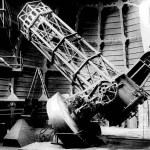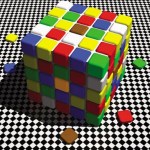Optics
Over at Tor.com, Kate has a Lord of the Rings re-read post about the Battle of the Pelennor Fields, which includes a shout-out to me that I missed because I was driving to NYC:
Ãomer is "scarely a mile" away when the standard unfurls and is clearly seen to bear the White Tree, Seven Stars, and a high crown. If I were at home, I could ask the resident scientist to tell me how big these elements would need to be to be visible at a mile, but I'm finishing this post on the train down to New York City (vacation! Woo! I'm going to try and write the next post while I'm there, too, so as to make up…
Voting has closed on the Laser Smackdown poll, with 772 people recording their opinion on the most amazing of the many things that have been done with lasers in the fifty years since the invention of the first working laser (see the Laserfest web site for more on the history and applications of lasers). The candidates in the traditional suspense-building reverse order:
Lunar laser ranging 22 votes
Cat toy/ dog toy/ laser light show 41 votes
Laser guide stars/ adaptive optics 46 votes
Holography 47 votes
Laser eye surgery 53 votes
Optical storage media (CD/DVD/Blu-Ray) 60 votes
Laser…
We're just over 600 votes in the Laser Smackdown poll in honor of the 50th anniversary of the laser, as of early Friday morning. I notice that it has moved off the front page of the blog, though, so here's another signal-boosting repost, just so we have as many votes as possible, to establish maximum scientific validity when we declare the winner the Most Amazing Laser Application of All Time
Which of the following is the most amazing application of a laser?Market Research
Voting will remain open until next Sunday, May 2, just two days from now, with the ultimate winner announced on Monday…
As of 1:45 Monday, 217 people have cast votes in the Laser Smackdown poll. That's not bad, but it's currently being handily beaten by the 271 people who have voted for a favorite system of units.
The nice thing about using actual poll services for this sort of thing, though, is that I can re-post the poll to boost signal a little. So, here it is again, a list of the twelve most amazing laser applications suggested by my wise and worldly readers, with links to short explanations of the pros and cons of each:
Which of the following is the most amazing application of a laser?Market Research…
What's the application? Producing artificial "stars" to serve as a reference for telescopes using adaptive optics to correct for atmospheric turbulence. This allows ground-based telescopes to produce images that are as good as those from the Hubble Space Telescope.
What problem(s) is it the solution to? "How can I make this giant telescope produce even more impressive pictures?"
How does it work?The basic problem with ground-based telescopes, as anyone who has ever looked at the stars or listened to nursery rhymes can tell you, is that stars "twinkle." They appear to fluctuate in brightness…
What's the application? An optical frequency comb is a short-duration pulsed laser whose output can be viewed as a regularly spaced series of different frequencies. If the pulses are short enough, this can span the entire visible spectrum, giving a "comb" of colored lines on a traditional spectrometer. This can be used for a wide variety of applications, from precision time standards to molecular spectroscopy to astronomy.
What problem(s) is it the solution to? 1) "How do I compare this optical frequency standard to a microwave frequency standard?" 2) "How do I calibrate my spectrometer well…
What's the application? Using lasers to cut and/or cauterize tissue during surgical procedures, instead of the traditional very small very sharp knives.
What problem(s) is it the solution to? 1) "How can we do surgery without touching the tissues being operated on?" 2) "How can I get rid of these annoying glasses/contact lenses?"
How does it work? First, you strap a device to your head that lets you shoot laser beams from your forehead, like one of the X-Men. then you use a magnifying glass to focus it to where it needs to be. Like so:
(I'm not sure exactly what sort of procedure that is,…
What's the application? Holograms are images of objects that appear three-dimensional-- if you move your head as you look at a hologram, you will see the usual parallax effects, unlike a normal photograph, which is fixed. So, if your hologram includes one object that is partly behind another object, you can see around the obstruction by moving a bit to the side, just as you would if the original objects were in front of you.
What problem(s) is it the solution to? 1) "How can we jazz up flat images and make them look more lifelike?" 2) "How can we make credit cards harder to copy?"
How does it…
What's the application? Optical tweezers use focused light beams to trap small particles in the focus of the beam, and drag them around by moving the beam.
What problem(s) is it the solution to? 1) "How do we move these tiny little things around without touching them?" 2) "How do we measure the forces exerted by biological molecules?" 3) "How do we tie knots in DNA strands?"
How does it work?The basic optical tweezer scheme uses a single beam of light focused down to a very small spot. If you take some small (mostly) transparent object and place it in the beam, it will feel a force pulling it…
What's the application? Using lasers to reduce the speed of a sample of atoms, thereby reducing their temperature to a tiny fraction of a degree above absolute zero.
What problem(s) is it the solution to? 1) "How can I make this sample of atoms move slowly enough to measure their properties very accurately?" 2) "How can I make this sample of atoms move slowly enough for their quantum wave-like character to become apparent?"
How does it work? I've written about laser cooling before, but the nickel version of the explanation is this: You can think of a beam of light as being made up of photons…
What's the application? The use of lasers to provide an entertaining light show for humans, dogs, or cats.
What problem(s) is it the solution to? 1) "How will I entertain my dog or cat?"
2) "How can we distract people from the fact that Roger Daltrey has no voice left?"
Why are lasers essential? Lasers provide coherent beams of light, which remain small over very large distances, allowing you to project a small spot or a tight beam across a room, or even a football stadium.
Why is it cool? Duuuuude! Lasers, duuuuude!
Why isn't it cool enough? 1) It's fundamentally just a toy. 2) No amount…
A couple of weeks ago, I announced a contest to determine the Most Amazing Laser Application. After a follow-up post listing the likely candidates, we have a final list of candidate applications, an even dozen of them (after consolidating some related topics):
Cat toy/ dog toy/ laser light show
Laser cooling/ BEC
Laser ranging/position measurement
Optical tweezers
Optical storage media (CD/DVD/Blu-Ray)
LIGO
Telecommunications
Holography
Laser ignited fusion
Laser eye surgery
Laser frequency comb/ spectroscopy
Laser guide stars/ adaptive optics
Here's how this will work: over the next week…
I often get asked to photograph odd things, more times than not the project changes when an art director decides to take a different path for an article. Such requests are a great source of ideas.
In this case a request was for triboluminescence. This is where my background in physics and optics is a big help. Triboluminescence is an optical phenomenon in which light is generated when asymmetrical crystalline bonds in a material are broken when that material is crushed. There are a number of materials that do this including quartz, sugar and even ice. In this image I am hitting a…
There's been a fair bit of press for the article Subtracting photons from arbitrary light fields: experimental test of coherent state invariance by single-photon annihilation, published last month in the New Journal of Physics, much of it in roughly the same form as the news story in Physics World (which is published by the same organization that runs the journal), which leads with:
A property of laser light first predicted in 1963 by the future Nobel laureate Roy Glauber has been verified by physicists in Italy.
These stories can be a little puzzling, though. After all, Glauber got his…
I was doing a little research into the history of telescopes, and it was about a century ago that they finally realized how much more potential light-gathering power reflecting telescopes had as compared to the older refracting telescopes. On Mt. Wilson in California, astronomer George Ellery Hale and optician George Willis Ritchey (back then everybody was named George -- look it up!) were embarking on a program to build large reflecting telescopes as the wave-of-the-future of Astronomy.
But even before this telescope was operational, Hale and Ritchey were thinking of bigger and bigger…
Starts With A Bang! is off to a great start; each the past three days we have topped the 100 visitor mark, bringing our total number of unique visitors up to 1,413! I'm going to attempt to start a new tradition here of making a weekend post on a topic that I just find neat, and share it with you. This first Weekend Diversion is an optical illusion about color. Take a look at the image below:
Looks like a cube with a bunch of different colors on it. Now do the following:
Look at the top face of the cube, and tell me what color the tile in the middle of that face is.
Look at the near face,…

